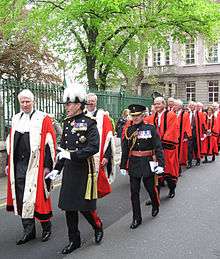Liberation Day (Channel Islands)
In Jersey and Guernsey, Liberation Day (Jèrriais: Jour d'la Libéthâtion) is celebrated each year on 9 May, to mark the end of the occupation by Nazi Germany during World War II. It is celebrated as Guernsey and Jersey's national day.[1][2]
| Liberation Day | |
|---|---|
 Liberation Day in Jersey, 2007 | |
| Official name | Liberation Day |
| Observed by | Guernsey, Jersey |
| Type | National Day |
| Date | 9 May |
| Frequency | annual |
| Related to | German occupation of the Channel Islands during World War II |
History

On 9 May 1945, HMS Bulldog arrived in St Peter Port, Guernsey, and the German forces surrendered unconditionally aboard the vessel at dawn. British forces landed in St Peter Port shortly afterwards, greeted by crowds of joyous but malnourished islanders singing, amongst other patriotic songs, "Sarnia-Cherie".[3]
The same day, HMS Beagle, which had set out from Plymouth, arrived in Jersey to accept the surrender of the occupying forces there. Two naval officers, Surgeon Lieutenant Ronald McDonald and Sub Lieutenant R Milne, were met by the Harbour Master, who escorted them to his office where they together hoisted the Union Flag, before also raising it on the flagstaff of the Pomme D'Or Hotel. This has been re-enacted every year on Liberation Day since 1995. From 2003 to 2011 former Harbour Master and Jerseyman Captain Howard Le Cornu performed this annually. His father, John E. Le Cornu, and uncle, David M. Le Cornu, had been in the crowds and had witnessed the occasion on 9 May 1945.[4][5]
Sark was liberated on 10 May 1945, and the German troops in Alderney surrendered on 16 May 1945.
Official status
The Public Holidays and Bank Holidays (Jersey) Act 1952 established Liberation Day as a public holiday if it fell on a weekday.[6] The Public Holidays and Bank Holidays (Jersey) Act 2010 further laid down that Liberation was also to be a public holiday if it falls on a Saturday.[7] It is not a public holiday, and no day off in lieu is provided, if it falls on a Sunday.[8]
Ceremonies

Since the 50th anniversary of Liberation in 1995, a pattern of official ceremonies has developed based in and around Liberation Square in Saint Helier where the events at the Harbour Master's Office and Pomme D'Or Hotel occurred in 1945. Following a special sitting of the States of Jersey in the morning, States Members, clergy, the Bailiff of Jersey, the Lieutenant-Governor, Jurats, Crown Officers and other officials process from the Royal Square to Liberation Square accompanied by the Royal Mace and the Bailiff's Seal. An open air ecumenical service takes place in Liberation Square followed by the singing of "Man Bieau P'tit Jèrri"/"Beautiful Jersey" (in Jèrriais and English) and a re-enactment of the raising of flags (including that at Fort Regent). A parade of vintage and military vehicles, bands and service organisations is reviewed by the official party.
The afternoon community celebrations are of an informal character, including a programme of entertainments and stalls in Saint Helier.[9]
An official ceremony also takes place at the Crematorium where there is a memorial to victims and slave workers of various nationalities. Representatives of affected nationalities take part in the commemoration.[10]
In 1995, artist Eric Snell[11] designed the Liberation Monument in St Peter Port to commemorate Liberation day. The States of Guernsey commissioned the design for a new Liberation Monument to commemorate the 50th Anniversary of Liberation from the German occupying forces in 1945. The result is a truly amazing fusion of art and science. On the 9th May each year the shadow from the needle-like monument falls across a bench recording the events of that day at the exact same time they occurred. On the 9th May 1995, at 1.40 pm, His Royal Highness, the Prince of Wales, unveiled the Monument, to the accompaniment of a fly-past of military helicopters. The Monument continues to serve both its commemorative function and its utilitarian one, a popular spot for people to sit and enjoy the sunshine, and occasionally the shadow.[12]
See also
References
- "Plans to celebrate Liberation 75". gov.je. Retrieved 2020-05-12.
- Heath, Ian. "'I am hopeful that much of this work will not have been wasted'". www.jerseyeveningpost.com. Retrieved 2020-05-12.
- "Sarnia Chérie (Guernsey anthem) – Sung on Liberation Day in 1945".
- "Jersey youth vital to Liberation Day – Bailiff". BBC News. 9 May 2011.
- "Jersey celebrates Liberation Day anniversary". BBC News. 9 May 2011.
- "Public Holidays and Bank Holidays (Jersey) Act 1952". Archived from the original on 8 August 2014. Retrieved 13 May 2012.
- "Public Holidays and Bank Holidays (Jersey) Act 2010". Archived from the original on 8 August 2014. Retrieved 13 May 2012.
- "States of Jersey Official Report". Retrieved 13 May 2012.
- "Jersey islanders mark Liberation Day". BBC News. 9 May 2010. Retrieved 3 October 2012.
- "Never forget the price of freedom". Retrieved 13 May 2012.
- http://ericsnell.co.uk/commissioned-work/liberation-monument
- https://guernseydonkey.com/guernseys-liberation-monument-a-fusion-of-art-and-science/
External links
